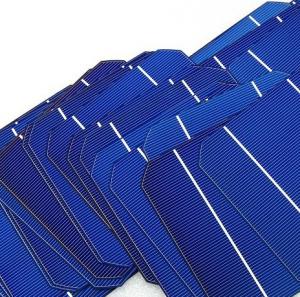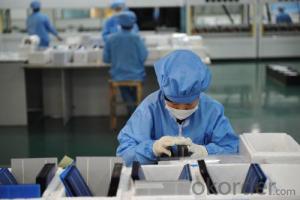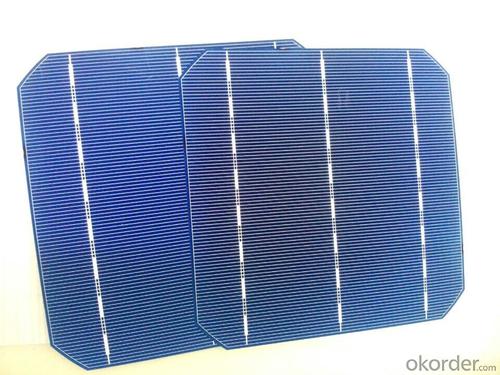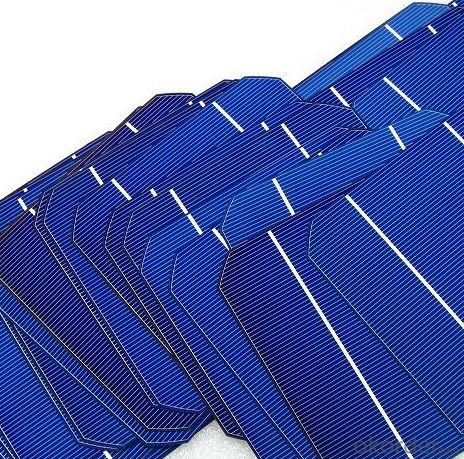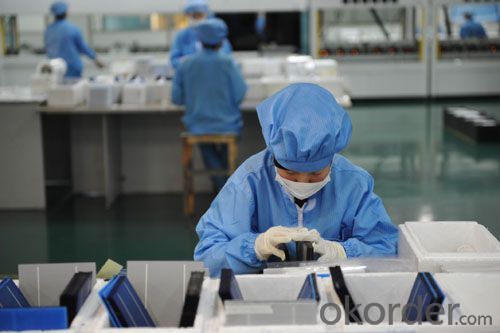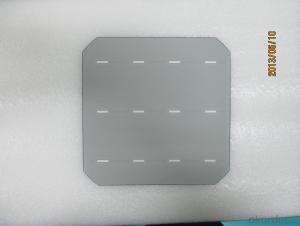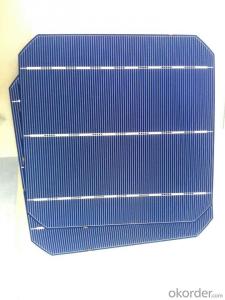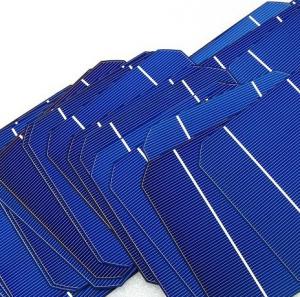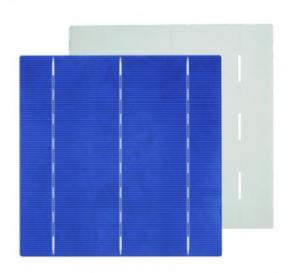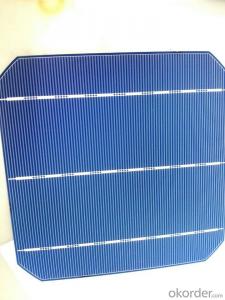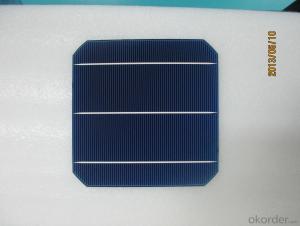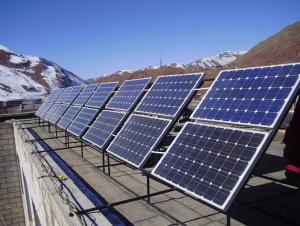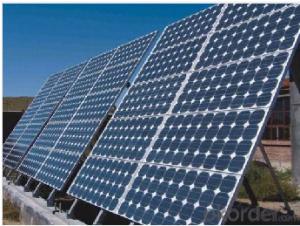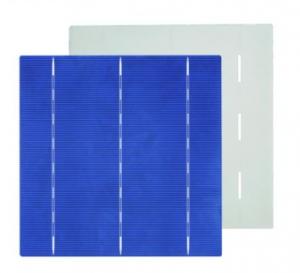Solar Cells Ebay - Monocrystal Solar Energy Cell 156*156mm with 18.9% Efficiency
- Loading Port:
- China Main Port
- Payment Terms:
- TT or LC
- Min Order Qty:
- -
- Supply Capability:
- 1000000 pc/month
OKorder Service Pledge
OKorder Financial Service
You Might Also Like
Monocrystal Solar Energy Cell
type:156M
appearance:156×1565㎜±0.5mm;diagonal:R=100mm
Main fence wide:1.4-1.5mm back electrode wide:2-2.5mm
Fence line qty:90
Cell thickness:220um±20um
Eff(%) | 18.80- 18.90 | 18.9- 19.0 | 19.1- 19.1 | 19.1- 19.2 | ||||||||
Pm(W) | 4.49 | 4.52 | 4.54 | 4.56 | ||||||||
Isc(A) | 8.86 | 8.88 | 8.9 | 8.93 | ||||||||
Im(A) | 8.42 | 8.45 | 8.47 | 8.51 | ||||||||
Voc(V) | 0.637 | 0.637 | 0.638 | 0.64 | ||||||||
Vm(V) | 0.535 | 0.536 | 0.537 | 0.538 | ||||||||
FF(%) | 79.8 | 80 | 80 | 80 |
remark:our company cells as per working current concentrate principle,separate the first and the second grade
Factory Picture of Solar Cells
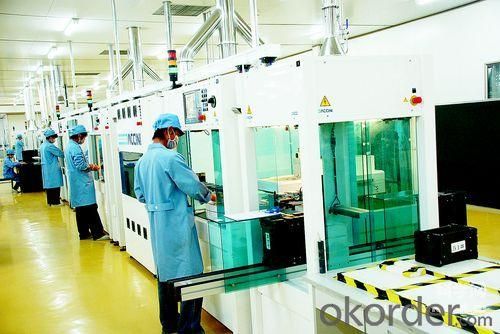

FAQ
We have organized several common questions for our clients,may help you sincerely:
What’s price per watt?
A: It’s depends on the quantity, delivery date and payment terms of the order. We can talk further about the detail price issue. Our products is high quality with lower price level.
Can you tell me the parameter of your solar cells?
We have different series of cells with different power output, both from c-si to a-si. Please take our specification sheet for your reference.
How do you pack your products?
We have rich experience on how to pack the panels to make sure the safety on shipment when it arrives at the destination.
Can you do OEM for us?
Yes, we can.
How long can we receive the product after purchase?
In the purchase of product within three working days, We will arrange the factory delivery as soon as possible. The perfect time of receiving is related to the state and position of customers. Commonly 7 to 10 working days can be served.
- Q: Can solar cells be used in high-altitude areas?
- Yes, solar cells can be used in high-altitude areas. In fact, solar cells can work even more efficiently in high-altitude locations due to the thinner atmosphere, which allows for greater solar radiation to reach the cells.
- Q: Can solar cells be used for powering transportation infrastructure?
- Yes, solar cells can be used to power transportation infrastructure. Solar-powered electric vehicles (EVs) have become increasingly popular and accessible. Additionally, solar panels can be installed on charging stations, parking lots, and even along roads to generate electricity for EVs. Solar energy can also be used to power electric trains and trams, reducing their reliance on fossil fuels. Furthermore, solar cells can be employed to power street lights, traffic signals, and other transportation infrastructure, helping to reduce carbon emissions and promote sustainability.
- Q: How do solar cells handle hail or other severe weather conditions?
- Solar cells are designed to withstand severe weather conditions including hail. They are made with durable materials such as tempered glass that can handle impact from hailstones. Additionally, solar panels are tested and rated for their ability to withstand extreme weather events, ensuring their resilience in harsh conditions.
- Q: How do solar cells perform in areas with high levels of air pollution and dust?
- Solar cells do not perform as efficiently in areas with high levels of air pollution and dust. The particles in the air can block sunlight from reaching the solar cells, reducing their ability to generate electricity. Additionally, the dust and pollution can accumulate on the surface of the solar panels, further decreasing their performance. Regular cleaning and maintenance are necessary to ensure optimal efficiency in such areas.
- Q: Can solar cells be used in disaster response vehicles?
- Yes, solar cells can be used in disaster response vehicles. They can provide a reliable and renewable source of power to charge essential equipment and devices, such as communication systems, lights, and medical equipment. Solar cells are especially useful in remote or off-grid areas where traditional power sources may be disrupted or unavailable during a disaster.
- Q: Can solar cells be used in water pumps?
- Yes, solar cells can be used in water pumps. Solar-powered water pumps utilize solar panels to convert sunlight into electricity, which can power the pump. This enables the pumps to operate independently of grid electricity, making them ideal for remote areas or locations with limited access to electricity. Solar-powered water pumps are cost-effective, environmentally friendly, and can be used for various applications such as agriculture, irrigation, or supply of clean drinking water.
- Q: Can solar cells be used in water purification systems?
- Yes, solar cells can be used in water purification systems. Solar-powered water purification systems utilize solar energy to power the required processes, such as filtration, disinfection, and desalination. Solar cells can generate electricity from sunlight, which can be used to power pumps, UV lamps, or other components of the water purification system. This sustainable and environmentally friendly approach is particularly useful in areas with limited access to electricity or in off-grid locations.
- Q: How do solar cells compare to fossil fuels in terms of energy production?
- Solar cells have several advantages over fossil fuels in terms of energy production. Firstly, solar cells harness renewable energy from the sun, while fossil fuels are non-renewable and finite resources. Secondly, solar cells produce clean energy, emitting no greenhouse gases or pollutants, whereas fossil fuels release harmful emissions that contribute to climate change and air pollution. Additionally, solar cells can be installed on rooftops or in remote areas, making energy production more decentralized and less reliant on centralized power plants. However, solar cells currently have limitations in terms of efficiency and storage capacity, which fossil fuels have a higher energy density and can provide continuous power supply. Overall, solar cells offer a sustainable and environmentally-friendly alternative to fossil fuels, but further advancements are needed to fully replace their energy production capabilities.
- Q: Can solar cells be used in off-grid cabins or cottages?
- Yes, solar cells can definitely be used in off-grid cabins or cottages. Solar cells, also known as photovoltaic cells, convert sunlight into electricity, making them an excellent renewable energy source for remote locations. By harnessing the power of the sun, solar cells can generate electricity to power lights, appliances, and other electrical devices in off-grid cabins or cottages, allowing for a sustainable and independent energy solution.
- Q: Are there any library or exhibition halls where I can show students at school how the solar cells works?
- Why don't you arrange a tour to the solar cell library in downtown?
Send your message to us
Solar Cells Ebay - Monocrystal Solar Energy Cell 156*156mm with 18.9% Efficiency
- Loading Port:
- China Main Port
- Payment Terms:
- TT or LC
- Min Order Qty:
- -
- Supply Capability:
- 1000000 pc/month
OKorder Service Pledge
OKorder Financial Service
Similar products
Hot products
Hot Searches
Related keywords

